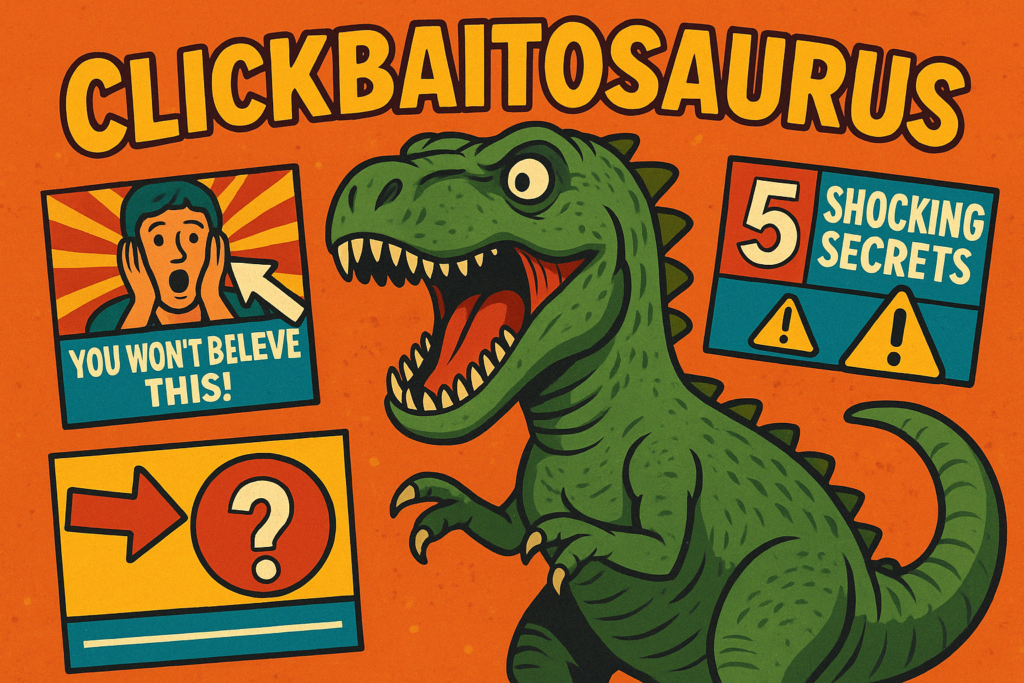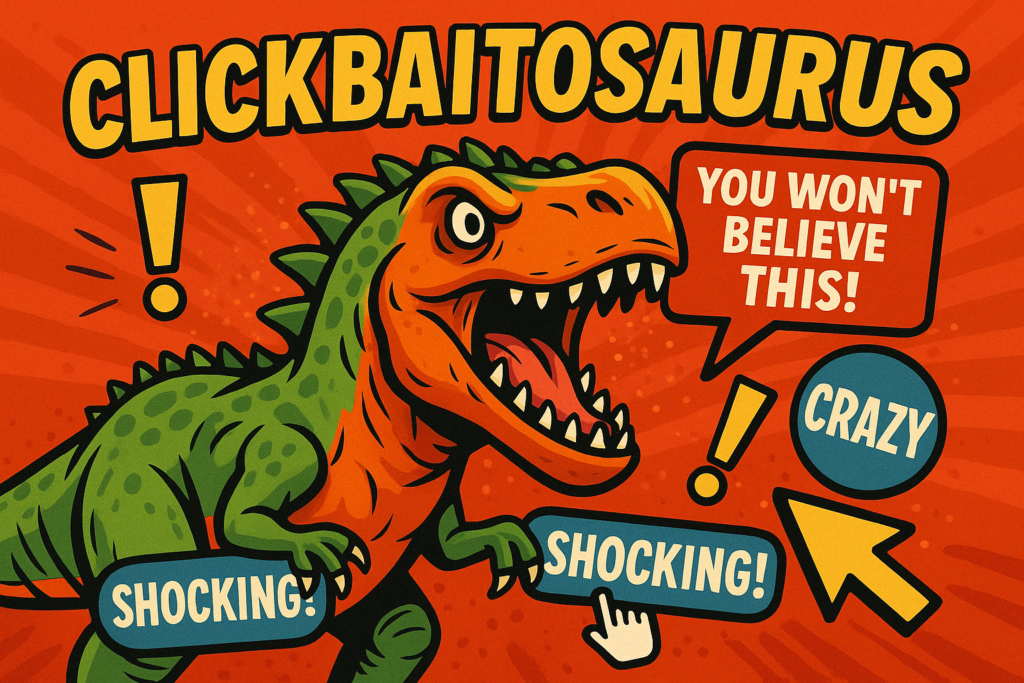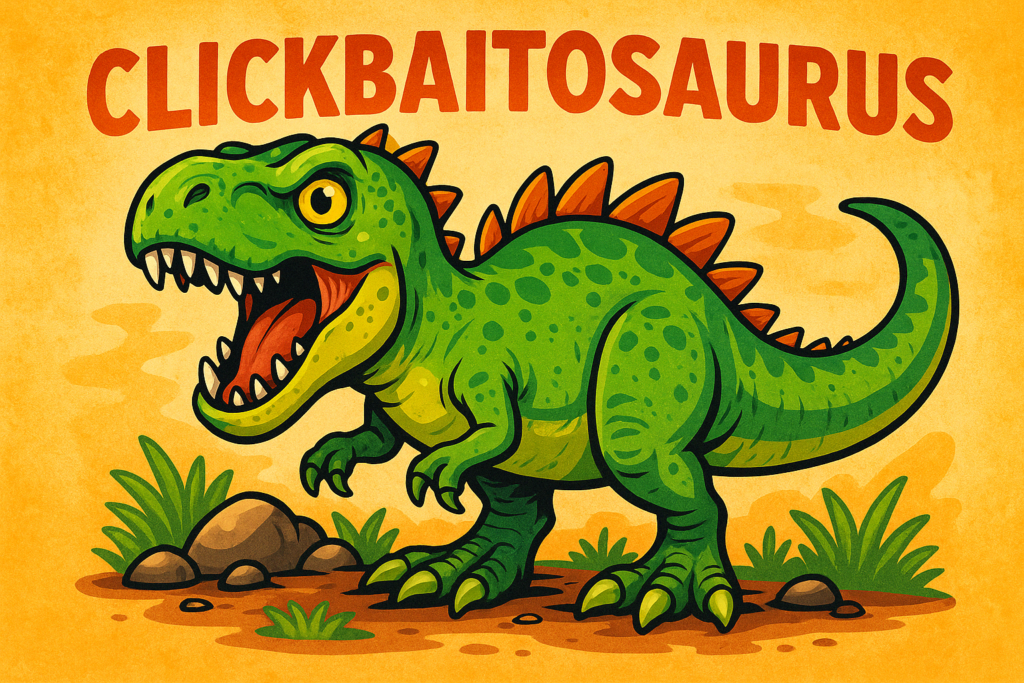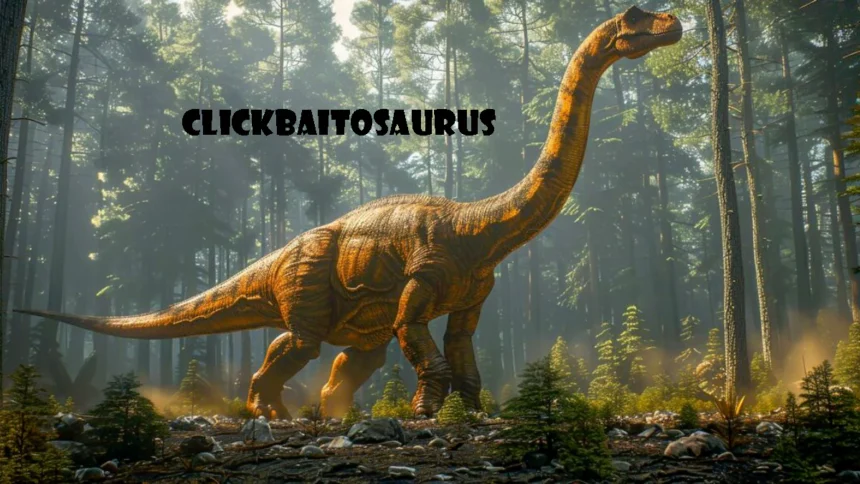Clickbaitosaurus is not a real dinosaur—it’s a funny and creative word used to describe exaggerated and misleading content found on the internet. It’s a mix of “clickbait” and “dinosaur,” symbolizing how old and outdated these tactics feel today. People use this term to make fun of websites, videos, or social posts that scream for attention but don’t deliver much value.
This word is now popular in memes, jokes, and even educational content. It helps internet users recognize when they’re being lured by silly, dramatic headlines or eye-catching thumbnails that don’t match the real content. While clickbait started as a marketing strategy, the idea of clickbaitosaurus turns it into a laughable relic of the past.
It’s used to raise awareness and bring humor to a frustrating part of internet life. Whether it’s a shocking YouTube title or a blog post with “you won’t believe this” in all caps, these are examples of clickbaitosaurus in action.
Even though we laugh at the term, it actually points to a serious issue. People waste time, get misled, and sometimes even fall for scams—all because of attention-grabbing tricks that the clickbaitosaurus represents.
The Evolution of the Clickbaitosaurus Phenomenon
Clickbait started many years ago when news websites realized dramatic headlines got more clicks. It worked well for a while—until everyone started doing it. Soon, the internet was full of crazy titles like “This Man Ate a Shoe and You’ll Never Guess Why!” That’s when users began noticing how silly and overused these tactics had become.
The term “clickbaitosaurus” was born as a joke, comparing clickbait content to a big, slow-moving dinosaur—something old, loud, and desperate to be noticed. It pokes fun at how outdated and ineffective these headlines are in today’s smarter internet world.
Over time, audiences grew tired of being tricked. They started avoiding websites and creators who always used bait tactics. As a result, many people now use the word “clickbaitosaurus” to warn others or criticize content that feels fake or manipulative.
This funny name gained popularity on social media, in educational blogs, and even in classrooms. People began treating it as a warning sign: if something looks like clickbaitosaurus, it probably isn’t worth your time.
Now, as internet culture continues to evolve, so does the use of this term—shifting from humor to media literacy.
Key Traits of Clickbaitosaurus Content
Clickbaitosaurus content is easy to spot. It usually has a loud, emotional headline that promises something shocking or unbelievable. For example, “This Simple Trick Will Change Your Life Forever!” or “Doctors Don’t Want You to Know This!” These titles play on curiosity and urgency.
Another trait is misleading images. A video thumbnail may show someone crying or something exploding, but the actual video might have nothing to do with it. These visuals are used to pull viewers in, not to reflect what’s inside.
Clickbaitosaurus content is also full of suspense. It keeps delaying the main point, trying to make users scroll longer or watch more. This way, the creator earns more ad revenue—even if the viewer doesn’t get what they expected.
Often, the content includes a lot of repetition, hype, and emotional tricks. But when it ends, the viewer feels confused or disappointed. That’s the hallmark of clickbaitosaurus—it looks huge but delivers very little.
This kind of digital creature survives on deception and drama. It wants attention, not trust.
Clickbaitosaurus on YouTube and Social Media
YouTube is a major home for the clickbaitosaurus. Many creators use thumbnails with shocked faces, red arrows, and huge bold text like “GONE WRONG” or “YOU WON’T BELIEVE THIS!” These images are carefully designed to stop viewers from scrolling.
Some videos are also filled with unnecessary suspense. Instead of giving the answer quickly, the creator drags it out for 10 minutes. The goal is to get longer watch time—not to educate or entertain honestly.
On social media, it’s even easier to spot clickbaitosaurus posts. Titles like “#7 Will Blow Your Mind” or “This Video Was Banned in 37 Countries” get shared fast—even if they’re fake or misleading. Platforms like Facebook and TikTok reward high engagement, so users are tempted to use clickbait just to get more likes or views.
These tactics may boost clicks temporarily, but they hurt a creator’s reputation in the long run. Once viewers realize they’ve been tricked, they’re less likely to return.
Still, many creators use clickbaitosaurus methods because they work—especially on people who aren’t aware of the trick.
Why Audiences Still Fall for Clickbaitosaurus Tactics
Despite its obvious flaws, clickbaitosaurus still catches many people. Why? Because it’s built on human psychology. People are naturally curious, and when a headline teases something mysterious or dramatic, our brains want to know more.
This is called the “curiosity gap.” It happens when you feel like you’re missing a piece of information—and you need to click to complete the story.
Another reason is the fear of missing out (FOMO). A post that says “Only Smart People Can Solve This” makes the reader want to prove their intelligence or avoid being left out.
Also, we live in a fast-scrolling culture. People don’t always have time to read carefully or check sources. They click quickly—and the clickbaitosaurus takes advantage of that speed.
Even though many people know what clickbait looks like, they still fall into the trap, especially if they’re tired, rushed, or distracted.
It’s not just about logic—it’s about how content makes people feel.
How Clickbaitosaurus Affects Online Trust
Clickbaitosaurus may seem funny, but it causes real damage to online trust. When users keep clicking on content that doesn’t deliver, they become skeptical. They stop believing headlines—even the honest ones.
This loss of trust affects creators, websites, and even major platforms. Viewers may unsubscribe, stop visiting pages, or leave angry comments.
Worse, fake news and scams often hide behind clickbait. A false medical cure, misleading celebrity rumor, or political lie can spread quickly because of a dramatic title. This creates confusion and harms people.
As a result, platforms like YouTube, Facebook, and Google have started cracking down on clickbait. They demote low-quality content and promote more reliable sources.
Still, trust is hard to rebuild once it’s lost. That’s why creators must avoid becoming part of the clickbaitosaurus tribe—and users must stay alert.
Memes, Jokes, and Art Inspired by Clickbaitosaurus
The internet loves humor—and clickbaitosaurus has become the perfect joke character. It often appears in memes that mock the absurdity of modern content tricks. These memes show dinosaurs with speech bubbles like “You’ll never believe what I ate!” or “My extinction will SHOCK you!”
Many artists and content creators have also visualized clickbaitosaurus in comic strips, parody videos, and artwork. It’s sometimes drawn as a big T-Rex holding a phone, shouting flashy headlines. These visuals make fun of the emotional drama seen in thumbnails and news posts.
Social media platforms like Twitter and Reddit are filled with hashtags, joke threads, and satire based on the clickbaitosaurus concept. Some even create fake accounts pretending to be the creature, writing hilarious bait headlines.
This creative response is more than just a joke. It’s how people express their frustration with dishonest content in a fun way. Humor becomes a tool for awareness, helping people recognize when they’re being misled.
Through these memes and art pieces, the clickbaitosaurus becomes both a warning and a laughable relic of internet behavior.
Educational Use of the Term in Media Literacy
Clickbaitosaurus isn’t just a joke—it’s now used as an educational concept in schools, workshops, and online learning programs. Teachers use it to explain how online misinformation works and how users can protect themselves.
When students hear about a “clickbait dinosaur,” they instantly become curious. It makes learning about serious issues like media manipulation more approachable and relatable.
Digital literacy programs often use clickbaitosaurus in videos and exercises that teach how to spot fake headlines, understand emotional manipulation, and verify sources. By practicing with real-life examples, students get better at thinking critically.
Even some libraries and public campaigns have adopted the concept to raise awareness about clickbait and online scams. Cartoons or posters with the creature help explain how not to fall for low-quality or harmful content.
So, clickbaitosaurus becomes a classroom tool—transforming a digital annoyance into a helpful teaching moment.
Battling the Clickbaitosaurus: Tips for Users
If you want to avoid falling into the traps of clickbaitosaurus, you need to build your “internet armor.” Start by slowing down—don’t click on every exciting headline. Instead, ask: “Is this too dramatic to be real?”
Use browser tools like link preview extensions or “hover cards” that let you check what’s behind the headline before clicking. This helps prevent disappointment or exposure to harmful content.
Support creators who are transparent and trustworthy. If a YouTuber or writer provides clear, honest titles and high-quality content, give them your engagement instead.
You can also report or downvote misleading posts on platforms like Reddit, YouTube, or Facebook. Every time you skip or flag clickbait, you reduce its power.
Most importantly, share media tips with friends and family. Teaching others how to recognize clickbait helps build a stronger and safer internet for everyone.
The Future of Clickbaitosaurus in Digital Culture
Clickbaitosaurus might be an ancient creature—but it’s not extinct yet. Many websites and creators still use flashy, dishonest tactics because they work. However, the internet is starting to evolve.
More users today demand authenticity. Platforms are rewarding high-quality content over pure engagement. Creators who offer value are gaining loyal followings, while those relying on tricks are slowly losing influence.
Tools like AI are also helping detect and reduce misleading content. Search engines and social networks now rank pages lower if they rely on bait-and-switch techniques.
In the future, the clickbaitosaurus may become less common—not because people forget it, but because they’ve outgrown it. It will remain a symbol of what the internet once was, and a reminder of what it should not become again.
As media literacy grows, clickbaitosaurus may fade into history—just like the dinosaurs that inspired its name.
Conclusion
Clickbaitosaurus is more than just a funny name—it represents an internet habit that many people are trying to move past. It reminds us how quickly the online world can become filled with noise and nonsense just to grab attention.
By understanding what clickbaitosaurus is, we learn how to protect ourselves from misleading headlines and false promises. Recognizing these tricks helps us make better decisions online.
It also teaches content creators an important lesson: trust matters more than clicks. Honest, valuable content builds loyal followers, while bait tactics only bring short-term gains.
Memes, jokes, and awareness campaigns have turned this silly digital “dinosaur” into a useful tool. People now use humor to educate others about online scams, fake news, and emotional manipulation.
In the end, avoiding the clickbaitosaurus helps create a smarter, safer, and more trustworthy internet—for everyone.
Also Read:
That-bites.org foodies: A Delicious Destination for Culinary Enthusiasts
Greece Katz Martian: Culture, Art, and Unexplained Visions
Quotela.net: A Modern Destination for Daily Inspiration, Quotes, and Lifestyle Trends
#mobilecreativeorg: The Rise of Mobile-First Creativity Worldwide
Numa Zara Builds a Community-Driven Brand Through Influencer Micro-Models
Xlecz and Smart Cloud Integration: How It Simplifies Infrastructure Without Compromising Innovation












